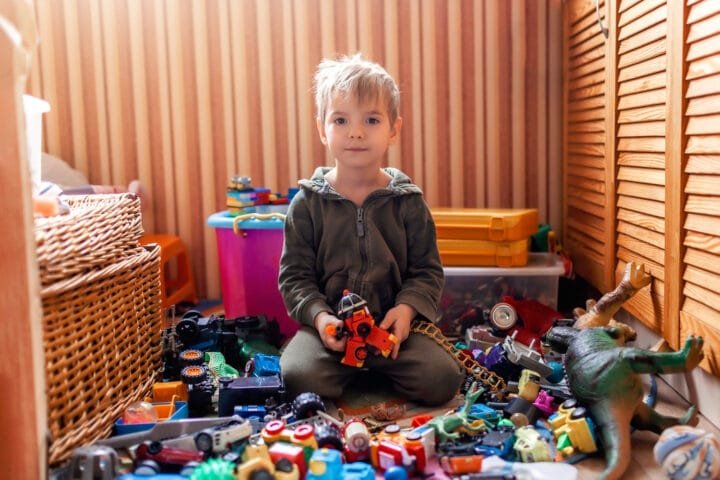The Invisible 70%: Why Mothers Are Drowning in Mental Load While Dads Get Praised for Changing Diapers
Picture this: It’s 3 AM. You’re wide-awake calculating childcare costs while your husband sleeps soundly beside you. Tomorrow, you’ll juggle eight Zoom meetings, remember it’s Wacky Wednesday at school (costume required), schedule three doctor appointments, and figure out dinner using whatever’s about to expire in the fridge. Meanwhile, your partner will change one diaper and receive a standing ovation from his mother. Welcome to the mental load gap – where mothers silently manage 70% of household cognitive labor while society celebrates fathers for doing the bare minimum.
A groundbreaking study from the University of Bath and University of Melbourne has confirmed what women have felt for generations – mothers bear a staggering 71% of the household mental load. This isn’t just about who folds the laundry; it’s about who remembers to buy detergent, notices when children outgrow clothes and keeps track of which kid hates which vegetable this week. It’s invisible work that keeps families functioning but receives almost no recognition.
Let’s explore why this imbalance persists, what it really costs mothers, and how families can finally distribute the cognitive burden more equitably.
I. The Unseen Burden: Defining the Mental Load Crisis
The shocking statistic: Mothers managing 70% of household mental labor
The numbers tell a story that many mothers have lived but few have seen quantified. Recent research published in the Journal of Marriage & Family reveals that mothers take on an overwhelming 71% of all household mental load tasks. The study, conducted in the US, examined data from 3,000 parent respondents and found that mothers handle 71% of household tasks that require mental effort—60% more than fathers, who manage just 45%1.
This isn’t just about physical chores. The “mental load,” also known as “cognitive household labor” refers to the thinking work needed to keep family life running smoothly. This includes scheduling, planning, and organizing tasks1. It’s the constant background processing that mothers perform, often without recognition or support.
Experts break this hidden work into three overlapping categories. There’s cognitive labor – which is thinking about all the practical elements of household responsibilities, including organizing playdates, shopping and planning activities. Then there’s emotional labor, which is maintaining the family’s emotions; calming things down if the kids are acting up or worrying about how they are managing at school. Third, the mental load is the intersection of the two: preparing, organizing and anticipating everything, emotional and practical, that needs to get done to make life flow.4
Beyond physical tasks: The cognitive dimension of family management
When we talk about household labor, visible tasks like washing dishes or mowing the lawn often dominate the conversation. But even in couples who think that they have achieved an equal division of labor, the more hidden forms of care generally end up falling to the woman. In fact, an increasing body of research indicates that, for household responsibilities, women perform far more cognitive and emotional labor than men.4
This cognitive work is particularly insidious because it’s always running in the background. This hidden work has various impacts; we know, for instance, that women are more likely than men to worry about childcare even when they are not with their children. It also causes additional stress, because it is always present – even when you should be concentrating on other things. “The mental load is that thread that brings the family into your work life,” says Leah Ruppanner, an associate professor of sociology at the University of Melbourne and author of Motherlands. It’s the constant low-level worry about whether we’re doing enough and the impact our parenting will have on our child’s future.4
The mental load operates silently but demands constant attention. It’s remembering to schedule dental appointments, knowing which child needs new shoes, planning birthday parties’ months in advance, and maintaining the social calendar for the entire family. It’s cognitive labor that’s rarely acknowledged but always expected.
Real mothers, real stories: Lived experiences of mental overload
Sarah, a marketing executive and mother of two, describes her experience: “My husband is a great dad and helps around the house, but he never thinks about what needs to be done until I point it out. I’m constantly maintaining an inventory of our household needs in my head – who needs new clothes, when permission slips are due, what birthday gifts need to be bought. The physical tasks aren’t the problem; it’s the constant mental scanning and planning that exhausts me.”
This experience isn’t isolated. Across different cultures and socioeconomic backgrounds, mothers report similar frustrations. Constant vigilance, planning, and emotional management become a 24/7 job with no off switch.
As Dr. Ana Catalano Weeks, a political scientist from the Department of Politics, Languages & International Studies at the University of Bath explains, “This kind of work is often unseen, but it matters. It can lead to stress, burnout and even impact women’s careers. In many cases, resentment can build, creating strain between couples.”1
II. The Science Behind the Statistic: Research and Evidence
Landmark studies confirming the 70% imbalance
The research confirming this mental imbalance is robust and consistent. Allison Daminger, a Ph.D. candidate in sociology and social policy at Harvard University, published a paper in the American Sociological Review that breaks down the mental load — “cognitive labor,” in sociological terms — into four parts: anticipate, identify, decide, monitor. If we’re using the summer camp example, “anticipate” is realizing we need to start thinking about options for the summer before they fill up; “identify” is looking into the types of camps that will suit our family’s needs; “decide” is choosing the camp; and “monitor” is making sure the kids are signed up and their medical forms are sent in.8
In fact, Daminger identified four clear stages of mental work related to household responsibilities: anticipating needs, identifying options, deciding among the options and then monitoring the results. Mothers did more in all four stages, her research showed; while parents often made decisions together, mothers did more of the anticipation, planning and research. In other words, fathers were informed when it came to decisions, but mothers put in the legwork around them.4
The research is clear and consistent across populations. The mental load imbalance isn’t just a perception or complaint – it’s a measurable phenomenon that affects families across socioeconomic and cultural boundaries.
Neurological and psychological impacts of carrying the mental load
The constant cognitive juggling required to manage a household takes a measurable toll on mothers’ brains and psychological well-being. Research shows that the always-on thinking mode associated with mental load contributes to decision fatigue, stress hormone elevation, and disrupted sleep patterns.
This kind of work is often unseen, but it matters. It can lead to stress, burnout and even impact women’s careers.1 The mental fatigue that comes from constant planning, anticipating, and remembering creates a cognitive burden that affects every aspect of a mother’s life – from career performance to personal well-being.
Mothers who take on a more disproportionate share of cognitive household labor report higher levels of depression, stress, relationship dissatisfaction and9 reduced quality of life. This isn’t just about fairness; it’s about health and well-being.
Economic implications of unrecognized labor
The economic impact of this uneven distribution of mental load extends far beyond individual households. The gender divide in the mental load doesn’t just affect family life—it impacts women in the workplace and public life. A recent Gallup study shows working mothers are twice as likely as fathers to consider reducing their hours or leaving their jobs due to parental responsibilities.1
If women are over-stretched at home, moreover, that means many feels they cannot physically or mentally put in the extra hours demanded by many workplaces, so the gender pay gap continues to widen. Women make up the majority of part-time workers, for instance, and in turn are less likely to get pay rises or promotions after having children, making it even harder to pursue top jobs. Many leave the workforce altogether.4
If U.S. parents were compensated for maintaining a household’s daily activities and schedule, it would amount to a staggering $3.8 trillion7 in economic value. The unpaid and unrecognized mental labor that mothers perform represents an enormous contribution to the economy that remains largely invisible in economic calculations.
III. The Ripple Effect: Consequences Beyond Exhaustion
Maternal health outcomes linked to mental overload
The health implications of carrying the mental load extend beyond temporary fatigue. Chronic stress associated with constant planning and worrying can lead to physical manifestations including headaches, digestive issues, compromised immune function, and disrupted sleep patterns.
Mental health is equally affected. Mothers carrying a disproportionate mental load report higher rates of anxiety, depression, and feelings of isolation. The constant pressure to remember, anticipate, and manage can create a state of perpetual vigilance that makes true relaxation impossible.
Long-term, these health impacts can alter a mother’s overall wellness trajectory, potentially leading to chronic health conditions and reduced quality of life. The mental load isn’t just an inconvenience; it’s a public health concern.
Relationship deterioration patterns
In many cases, resentment can build, creating strain between couples.1 The imbalance in mental load often leads to communication breakdown as mothers feel both overwhelmed and unheard.
One Swedish study showed that when women thought the distribution of the more obvious housework was unfair and perceptions of each partner’s contribution differed, it led to marriage problems and increased the likelihood of a split. The risk is also exhaustion for the mothers, who might initially ask for help, which can come across as nagging if it has to be repeated again and again. “And then that wears on relationships,” says sociologist Daniel Carlson of the University of Utah, who found that unequal distribution of caring responsibilities in couples can also lead to less sex.4
When one partner is constantly scanning the horizon for potential needs while the other waits to be told what to do, the relationship dynamic shifts from partnership to management. This parent-child dynamic erodes intimacy and mutual respect over time.
Children’s perception and future gender role adoption
Perhaps most concerning is how children internalize these household patterns. More powerfully, gendered expectations that start from birth can explain why ideas around who does the housework and childcare are so ingrained. Daughters are known to do more housework than sons, for instance.4
Children are keen observers who absorb the division of labor in their homes as “normal.” When they consistently see one parent (typically the mother) managing the household cognitive load, they internalize these patterns as gender-appropriate behavior. Sons grow up expecting women to manage household planning, while daughters assume they’ll naturally take on this role.
This intergenerational transmission of mental expectations perpetuates the imbalance across generations. Breaking this cycle requires conscious modeling of equitable household management.
IV. Behind the Imbalance: Root Causes of the 70/30 Split
Socialization and gender expectation foundations
The roots of mental imbalance stretch back to early childhood socialization. Motherhood ideals also feed into this equation. For instance, the home is often seen as a woman’s domain. We know that women are judged on neatness more harshly than men. One study showed that if an identical room for a prospective rental property was said to belong to Jennifer rather than John, Jennifer was rated less likeable, less competent and less hardworking than John. The conclusion? The state of a woman’s home was literally linked to her worth.4
Media reinforces these expectations, portraying mothers as natural household managers while depicting fathers as bumbling but well-meaning assistants. Commercials, TV shows, and films consistently show women remembering birthdays, organizing family events, and maintaining the home’s emotional temperature while men need reminders and guidance.
Institutional structures from school communication (typically directed at mothers) to pediatrician interactions (questions often addressed to mothers even when both parents are present) further cement these expectations. These subtle reinforcements create a powerful social narrative that household management is fundamentally women’s work.
The competence paradox: How skill development creates imbalance
A self-reinforcing cycle emerges when mothers handle most household planning and management: they become more skilled at it through practice, while their partners’ skills stagnate through lack of use.
These were well-educated participants who agreed to take part, so they may not be fully representative, but it still gives an interesting insight into a misconception that other studies have debunked – women aren’t naturally better at planning, organizing or multitasking, they are just expected to do it more and so eventually become better at it. Yet there are other structural reasons why women continue to take on more of the mental load. Women often find a way to work flexibly, whereas men’s jobs are seen as more rigid, their careers more traditionally linear. This means women are more available for childcare, do more of it – and as a result have to think about it more.4
What’s often labeled as “maternal instinct” is actually learned behavior resulting from thousands of hours of practice. The apparent ease with which many mothers manage complex household scheduling is not innate – it’s a developed skill that anyone could acquire with sufficient practice and expectation.
Workplace structures perpetuating home inequality
Workplace policies and expectations play a significant role in reinforcing mental load imbalance. Dr. Catalano Weeks said: “Going forward, the challenge for governments and employers who care about attracting the top talent is how to create policies that are supportive of both mothers and fathers sharing the unpaid work at home. One policy that comes to mind is well-paid, gender-neutral parental leave – which both the UK and US are way behind on compared to the rest of Europe.”1
When workplace cultures expect mothers to be primary caregivers while assuming fathers are unburdened by family responsibilities, the mental disparity is reinforced. Limited parental leave for fathers, inflexible work arrangements, and organizational cultures that penalize family engagement all contribute to the household management imbalance.
V. Breaking the Pattern: Strategies for Redistributing the Load
Individual approaches to mental load rebalancing
Changing entrenched patterns begins with awareness and communication. To foster new habits to help share the load, we must make the invisible more visible. An awareness of it is a good first step, agrees Daminger, and constantly being clear about who is managing which task, including the planning. If we explicitly state how much planning is involved in every aspect of childcare and housework, it will become clearer just how much hidden work we do.4
Effective redistribution requires more than task assignment – it requires transferring ownership of entire domains. Rather than a mother asking her partner to “help” with birthday planning (while retaining mental management), the entire process from conception to execution should transfer. This means the other parent becomes responsible for remembering the birthday, planning the celebration, purchasing supplies, and executing the event without prompting or management.
Setting clear boundaries around mental load responsibilities is crucial. This might mean explicitly stating what you will no longer track or manage, even if it means certain tasks go undone temporarily. While potentially uncomfortable in the short term, this boundary-setting is often necessary for sustainable change.
Partnership-level interventions
Structured systems for household management can help distribute cognitive labor more equitably. Shared digital calendars, task management apps, and regular family meetings create external infrastructure that reduces reliance on one person’s mental tracking.
Technology offers solutions specifically designed to address mental imbalance. Apps like Cozi, OurHome, and FamilyWall allow all family members to access calendars, shopping lists, meal plans, and to-do lists, making the previously invisible work visible and accessible to everyone.
Regular recalibration through household “audits” helps prevent backsliding into uneven patterns. Quarterly conversations about who’s managing which aspects of family life allow couples to identify and address imbalances before resentment builds.
Systemic and policy changes needed
Going forward, the challenge for governments and employers who care about attracting the top talent is how to create policies that are supportive of both mothers and fathers sharing the unpaid work at home. One policy that comes to mind is well-paid, gender-neutral parental leave – which both the UK and US are way behind on compared to the rest of Europe.1
Policy could help too – research shows that men who take paternity leave do more childcare later.4 When both parents have equal opportunity to bond with children and develop caregiving skills early, more equitable patterns tend to persist.
Educational approaches that challenge gendered assumptions about household management are equally important. From early childhood education that avoids reinforcing stereotypical roles to workplace training that acknowledges the reality of mental load, systematic education can help disrupt the patterns that lead to mental load imbalance.
VI. Measuring Progress: From 70/30 to True Partnership
Realistic milestones in the journey to balance
Progress in mental load redistribution doesn’t happen overnight. Short-term indicators might include increased awareness of previously invisible work, explicit conversations about who’s managing what, and a partner beginning to take ownership of specific domains without prompting.
Medium-term markers of improvement often appear in relationship quality: reduced resentment, more equitable leisure time, and a sense of partnership rather than management. When both partners feel they have similar amounts of mental space for themselves, progress is occurring.
Long-term success manifests in systemic and generational change. Children who grow up seeing equitable mental distribution tend to create balanced partnerships themselves. When mental load management becomes a skill, everyone is expected to develop rather than a gendered obligation, true progress has occurred.
When resistance emerges: Addressing backsliding and pushback
Resistance to mental load redistribution is common and takes many forms. Partners may claim they “don’t notice” certain needs, insist they’re “not good at” particular tasks, or suggest the managing partner is being “too particular” about how things are done.
But in the absence of policy, perhaps the best way for women to reduce the mental load is to do less. Initially there may be pained to achieve any form of long-term gain, says Carlson. If the mother stops thinking about what needs to be done and the father does not anticipate these needs, it may initially cause stress or judgement – but that could allow learning for next time. “It’s kind of classic operant conditioning. We’re not putting men through mazes or shocking them for food pellets… but it’s kind of like, ‘Oh, I didn’t remember to do this last time and there was a negative consequence’.” Over time, doing less could increase our partner’s involvement and, in turn, free up more of our mental energy to focus on ourselves. At first, we might get judged for it, but it could lead to greater happiness later on. We all learn from doing, after all.4
External pressure from family members, friends, or society to maintain traditional roles can also create friction. Developing clear responses to such pressure and maintaining a united front as partners helps navigate these challenges.
The benefits beyond fairness
Redistributing the mental load creates benefits far beyond basic fairness. Relationships improve when both partners feel seen, appreciated, and equitably burdened. The reduction in resentment and increase in mutual respect enhances intimacy and partnership satisfaction.
Children raised with balanced models develop more flexible views of gender and greater self-sufficiency regardless of gender. They learn that household management is a skill anyone can develop, not a gendered obligation.
Career and personal development opportunities expand for the previously overburdened partner as mental bandwidth is freed up. This creates more options for personal fulfillment and professional advancement that benefit the entire family.
VII. Conclusion: Lightening the Load, Sharing the Journey
Recapping the mental load crisis and its consequences
The research is clear: mothers take on seven in ten (71%) of all household mental load tasks. Mothers handle 71% of household tasks that require mental effort—60% more than fathers, who manage just 45%.1 This imbalance creates significant consequences for women’s health, relationships, and career trajectories.
The invisible nature of mental load has allowed this imbalance to persist despite advances in other aspects of gender equality. By making the invisible visible, measuring its impact, and understanding its causes, we can begin to address this final frontier of household inequity.
The moral imperative for change beyond individual households
This isn’t just about individual household happiness – it’s about creating a society where all parents can thrive. We hope our research sparks conversations about sharing the mental load more fairly—something that benefits everyone.1
When mental load is more equitably distributed, everyone benefits. Children see healthier relationship models, parents experience reduced stress and greater partnership satisfaction, and society benefits from the full participation of all parents in both family and professional life.
Envisioning a future where the statistic is history, not headline
Imagine a future where the 70/30 mental load statistic is a historical curiosity rather than a current reality. A world where household management is seen as a shared responsibility requiring skill development by all partners, not an inherently gendered task.
Fortunately, not all couples have unequal divisions of care: same-sex couples, for instance, have a much more equal distribution compared to heterosexual couples, as they are not beholden to expected gender roles. This shows that the load can clearly be shared when it is more openly talked about. If we explicitly state how much planning is involved in every aspect of childcare and housework, it will become clearer just how much hidden work we do.4
This future is possible, but it requires conscious effort at individual, partnership, and societal levels. By understanding the mental load, naming it, measuring it, and actively redistributing it, we can create more equitable households that benefit everyone involved.
Call to action: Small steps toward significant change
The researchers encourage families to take the first step: talk about the mental load, make a plan, and work together to make the holidays—and every day—more balanced.1
Start by having an open conversation about mental load in your household. Make the invisible visible by listing all the household and childcare tasks that require planning, research, or emotional management. Determine who’s currently managing each area and discuss whether that distribution feels equitable to both partners.
Choose one domain of household management to transfer completely to the partner who currently does less. Remember that complete transfer means both the execution and the mental management of that area.
Consider using technology tools to externalize the mental load so it’s visible and accessible to all family members. Shared calendars, task management apps, and digital shopping lists can help distribute cognitive labor more evenly.
Most importantly, recognize that redistributing the mental load isn’t just about fairness – it’s about creating households where all family members can thrive, relationships can flourish, and the next generation can develop healthier expectations about partnership and parenthood.
The 70% statistic doesn’t have to be our future. With awareness, intention, and action, we can create more balanced households where the mental load is shared, not shouldered primarily by mothers. This shift benefits not just individual families but society as a whole – and it starts with making the invisible visible.
FAQs
The mental load refers to the invisible cognitive and emotional work required to manage a household and family. This includes anticipating needs, planning, researching options, making decisions, and monitoring outcomes. Research shows mothers shoulder approximately 71% of this invisible work compared to fathers’ 45%. This gender disparity stems from deeply entrenched societal expectations, gender role socialization from childhood, workplace structures that assume mothers are primary caregivers, and a self-reinforcing cycle where mothers develop these skills through constant practice while partners remain less experienced. Unlike physical chores that have clear start and end points, mental load runs as constant background processing, making it particularly exhausting and difficult to measure or redistribute.
The consequences extend far beyond simple fatigue. Mothers carrying disproportionate mental loads experience measurable physical health impacts including disrupted sleep patterns, elevated stress hormones, headaches, digestive issues, and compromised immune function. Mental health consequences include higher rates of anxiety, depression, and burnout. Relationship satisfaction plummets as resentment builds, often creating a parent-child dynamic between partners rather than equal partnership. Career advancement suffers as cognitive resources are drained by household management, contributing to workplace gender gaps. Perhaps most concerning is the intergenerational impact, as children observe and internalize these patterns, perpetuating gender role expectations into the next generation.
Effective redistribution requires transferring complete ownership of domains rather than just delegating tasks. This means one partner takes full responsibility for both execution AND planning/management of entire categories like meal planning, gift purchasing, or children’s activities. Start by making the invisible visible—list all household cognitive tasks and who currently manages them. Use technology as external infrastructure through shared digital calendars, task management apps, and planning tools. Expect discomfort during transition periods, as the previously less-burdened partner develops new skills and makes mistakes. Regular check-ins (monthly or quarterly “household audits”) help prevent backsliding. Remember that redistribution isn’t about “helping” the overburdened partner—it’s about equal ownership of family management.
Resistance often manifests as claims of incompetence (“I’m not good at planning”), selective attention (“I don’t notice those things”), or criticism of standards (“You’re too particular”). Address these by framing mental load skills as learned, not innate—your partner wasn’t born knowing how to do their job either, but developed proficiency through practice and expectation. Sometimes strategic incompetence (deliberately doing poorly to avoid being asked again) requires direct conversation about the impact on your relationship. Consider temporal boundaries—letting certain things go undone temporarily can demonstrate the real value of your cognitive work. External validation can help; share research or articles about mental load so it’s not perceived as your personal complaint. Most importantly, hold firm boundaries—if your partner refuses to develop these skills despite understanding their importance, deeper relationship issues may need addressing.
Research shows the mental load imbalance is not inevitable. Same-sex couples demonstrate much more equitable distribution of cognitive household labor, proving these patterns aren’t biologically determined but socially constructed. Countries with stronger family-supportive policies (like gender-neutral parental leave and affordable childcare) show more balanced household management. Individual families who consciously address mental load distribution report higher relationship satisfaction and better outcomes for children, who grow up with more flexible gender expectations. While societal change is slow, individual households can create more equitable patterns through awareness, communication, and intentional redistribution of cognitive responsibilities. The most successful approaches combine individual changes, partnership agreements, and advocacy for policy changes that support equitable family management.
Top 5 Books About Mental Load, Emotional Labor, and Invisible Work for Mothers
This deeply researched examination of the invisible, uncompensated work women perform daily serves as a profound call to action. Hackman explores how emotional labor manifests in various situations – from the stranger insisting you “smile more” during a stressful commute, to mothers expected to oversee every detail of domestic life, to professionals denied promotion for not placating bosses. The book traces the history of emotional labor, shares stories from hundreds of women, and exposes common manifestations of this phenomenon. Beyond diagnosing the problem, Hackman empowers readers to combat this insidious force through radical evolution, justice, and change.
From the journalist who ignited a national conversation on emotional labor, this book takes a bold dive into the unpaid, invisible work women perform daily. Hartley explores the mental load that affects women across society and offers practical strategies for moving forward. This book resonates particularly with mothers who feel the disproportionate weight of household management.
A revolutionary system that helps partners rebalance their domestic responsibilities. Rodsky found a way to gamify the tasks of parenthood with the goal of getting both partners to share more responsibility in the home — not equally, but equitably. Fair Play identifies the 100 main tasks in any relationship and provides a framework for dividing those tasks fairly so both parties contribute appropriately. The book introduces four rules, covers 100 household tasks, and offers various conversation starters to help couples decide who should take the lead on which household chore. It’s particularly valuable for addressing both visible labor (like cooking dinner) and invisible labor (like anticipating and planning meals).
An illustrated memoir and guide that explores how so many mothers end up overwhelmed by the mental load of parenthood. Starr, creator of Momlife_Comics, critiques and pokes fun at the challenges and inequities of domestic life. Her viral comic strip “An Illustrated Guide to the Double Standards of Parenting” resonated with mothers worldwide. The book looks at the deep emotional trauma mothers experience as they transition into parenthood while facing a world that expects them to “do it all” while looking good. With humor and honesty, Starr addresses the mental load and double standards that define modern motherhood.
Following the success of “The Mental Load,” this collection of “visual essays which are transformative agents of change” continues exploring the invisible burdens disproportionately carried by women. The visual format makes complex concepts about emotional labor accessible and provides a powerful way to understand the cumulative impact of these invisible responsibilities.















































































